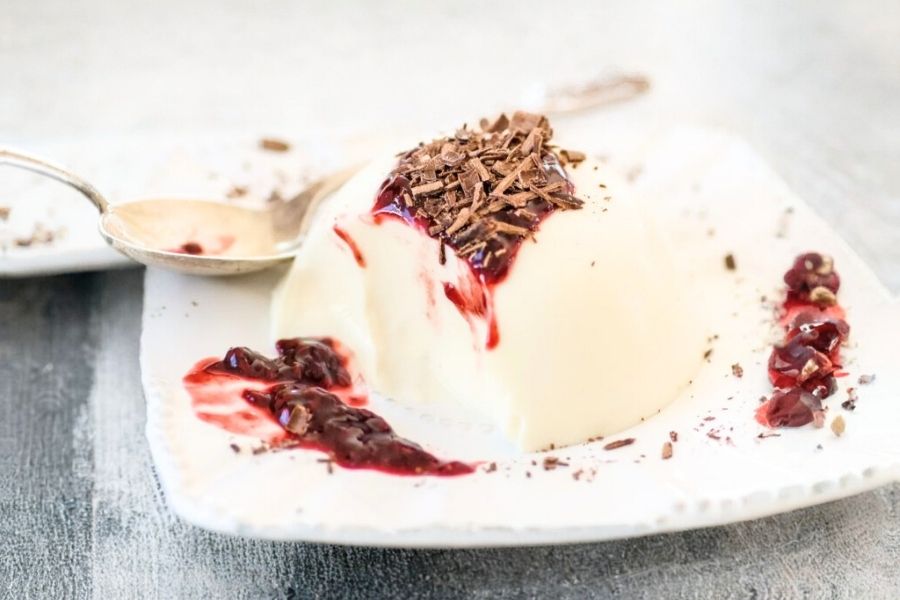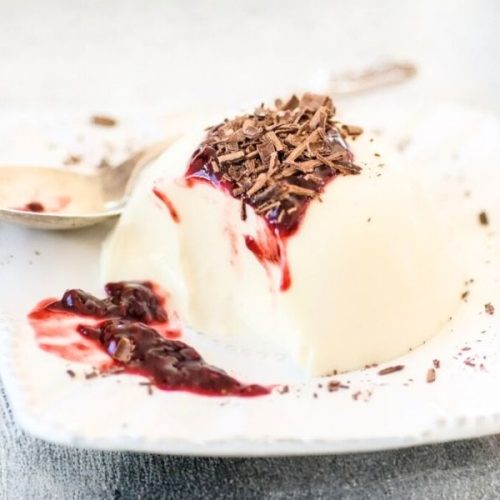Panna cotta is a timeless Italian dessert renowned for its silky texture and delicate flavor.
What makes this recipe especially appealing is its simplicity and versatility—just a handful of ingredients, minimal cooking, and a few hours chilling yield an elegant, creamy pudding.
Using gelatin ensures a smooth, satisfying set without the heaviness of traditional custards.
Nutritionally, panna cotta offers a moderate amount of protein from dairy and can be adjusted with different milk or cream types to control fat content.
Choosing whole milk and light cream balances good fats with creamy richness while keeping saturated fat moderate.
The recipe’s adaptability to alternative milks also caters to dairy-free needs.

Panna cotta shines as an everyday dessert option since it requires minimal hands-on time and is perfect for meal prep or entertaining—make it ahead, unmold just before serving, and enjoy a luscious, crowd-pleasing treat with very little fuss.
Must-Have Tools for Perfect Results
6-ounce Ramekins
Essential for portion control and perfect setting. Their individual size ensures uniform chilling and a beautiful presentation, doubling as versatile vessels for custards, soufflés, and more.
2-Quart Saucepan
Ideal for gentle heating of milk and gelatin without scorching. A medium-sized, heavy-bottomed pan distributes heat evenly, preventing boiling and ensuring smooth gelatin dissolution.
Whisk
Vital for thorough mixing of gelatin, sugar, and cream, creating a uniform, lump-free mixture. A whisk is a kitchen staple that speeds blending and emulsification across countless recipes.
Thin Knife
Used to loosen the panna cotta edges before unmolding. Its slim blade is perfect for delicate tasks and precise slicing, a handy tool for plating and serving finesse.
Large Bowl
Useful for prepping and chilling the ramekins and for water baths during unmolding. A versatile piece that supports prep work, mixing, and temperature control.

Classic Panna Cotta
Equipment
- 6 × 6-ounce ramekins
- 1 × 2-quart saucepan
- 1 × whisk
- 1 × large bowl
- 1 × thin knife
- Paper towels (for greasing ramekins)
Ingredients
- Cooking spray for greasing
- 1½ cups whole milk or preferred milk alternative
- 3 teaspoons powdered gelatin
- ⅓ cup granulated sugar
- 1½ cups light or heavy cream
- 1 teaspoon pure vanilla extract
- Pinch of salt
Instructions
- Prepare Your Ramekins: Start by lightly coating six 6-ounce ramekins with cooking spray. Then, use a paper towel to wipe away most of the oil, leaving just a faint layer. This helps the panna cotta release easily after setting.
- Soften the Gelatin: Pour the whole milk into a medium saucepan. Sprinkle the gelatin powder evenly across the surface of the milk and let it rest undisturbed for about 5 minutes.You'll notice the milk surface wrinkle slightly as the gelatin absorbs moisture and begins to soften.
- Gently Warm to Dissolve Gelatin: Place the saucepan over low heat. Slowly warm the milk and gelatin mixture, stirring gently but continuously with a whisk or spoon. The goal is to heat the liquid just enough for the gelatin to melt completely—avoid any boiling or simmering. The mixture should feel warm to the touch but comfortable enough to hold your finger in briefly.
- Confirm Gelatin Is Fully Melted: After 2–3 minutes of warming, test a small amount by rubbing it between your fingers or checking the back of a spoon. The liquid should feel smooth without any gritty gelatin granules. If you detect undissolved bits, continue warming briefly.
- Sweeten the Mixture: Add the granulated sugar to the warm milk and gelatin, stirring until fully dissolved. This process usually takes just a few minutes. Again, keep the heat low to prevent boiling, which would impair the gelatin’s setting ability.
- Incorporate Cream and Flavor: Remove the saucepan from heat. Whisk in the cream, vanilla extract, and a pinch of salt until everything is evenly combined, creating a luscious, smooth mixture.
- Pour and Chill: Divide the panna cotta mixture evenly into the prepared ramekins. Place them in the refrigerator to chill and set. For a softly set dessert served directly in the ramekins, chill for 1 to 2 hours. For panna cotta that can be unmolded onto plates, allow at least 4 hours, preferably overnight.
- Prepare for Unmolding: When ready to serve, fill a large bowl with warm (not hot) water. Lightly moisten a serving plate with a damp paper towel to help with repositioning the panna cotta once unmolded.
- Release Edges and Unmold: Run a thin knife carefully around the inside edge of each ramekin to loosen the panna cotta. Avoid inserting the knife too deeply to keep the dessert intact. Dip the ramekin rim into the warm water for about 3 seconds to gently warm the sides. Immediately invert the ramekin onto the prepared plate, gently shaking or pressing to release the panna cotta.
- Serve or Store: Serve the panna cotta immediately or cover and refrigerate for up to five days. Note that the gelatin firms more over time, potentially becoming firmer or slightly rubbery. To soften before serving, let it rest at room temperature for about 30 minutes.
Notes
- Milk and Cream Variations: While whole milk and cream provide a rich texture, you can experiment with half and half for a smoother, more consistent pudding. Dairy-free alternatives like coconut or almond milk work but may require a slight increase in gelatin for proper setting.
- Flavor Twists: Elevate your panna cotta by infusing the milk with a scraped vanilla bean, or try extracts like almond or lemon. For a fun twist, fold in chopped chocolate just before chilling or substitute part of the milk with espresso or fruit puree.
- Avoid Boiling: Never let the gelatin mixture boil; excessive heat destroys gelatin’s gelling power, resulting in a loose panna cotta.
- Layering Issues: If you see separation or layering, try homogenized half and half instead of separate milk and cream to maintain a uniform texture.
Chef’s Secrets for Perfect Panna Cotta
Achieving the perfect panna cotta hinges on gentle heat and patience.
Avoid boiling the gelatin mixture at all costs, as high heat breaks down gelatin’s setting power, resulting in a runny dessert.
Instead, warm the milk slowly over low heat, stirring frequently to dissolve the gelatin and sugar evenly.
Using homogenized half and half can prevent the separation of fat layers, ensuring a smooth, creamy texture.
For an extra layer of flavor, consider infusing the milk with a vanilla bean pod rather than extract—it releases aromatic oils that elevate the dessert’s richness.
When unmolding, warming the ramekin rim briefly in warm water makes the panna cotta slip out effortlessly, preserving its elegant shape.
Lastly, remember that chilling time is crucial: while panna cotta can be enjoyed straight from the ramekin after a couple of hours, allowing it to set overnight enhances firmness and texture.
Serving Suggestions to Impress Guests
Panna cotta’s subtle sweetness and creamy texture make it a versatile canvas for a variety of toppings and accompaniments.
Fresh seasonal berries such as raspberries, strawberries, or blueberries add bright color and a refreshing tartness that balances the richness.
A drizzle of fruit coulis or a spoonful of caramel sauce can bring extra indulgence.
For a sophisticated touch, garnish with edible flowers or a sprinkle of toasted nuts like pistachios or almonds for added crunch.
Pair panna cotta with a light dessert wine or a cup of rich espresso to complement its creamy profile.
Whether served in individual ramekins or unmolded onto a plate, panna cotta’s elegant simplicity allows you to customize presentation easily to suit casual family dinners or formal dinner parties.
Storage Tips to Keep Fresh Texture
Panna cotta is best enjoyed within a few days of preparation to maintain its creamy, delicate texture.
Once set, cover the ramekins or plated panna cotta loosely with plastic wrap or an airtight lid and refrigerate.
Stored properly, panna cotta can last up to five days, but keep in mind that gelatin firms over time, which can cause the dessert to become a bit rubbery by day four or five.
To restore a soft, silky feel before serving, allow it to sit at room temperature for about 20–30 minutes. Avoid freezing panna cotta as it can negatively affect the texture and cause separation.
If you plan to prepare panna cotta ahead for a gathering, chilling overnight is ideal for both flavor development and structural integrity.
Frequently Asked Questions Answered Clearly
1. Can I use gelatin sheets instead of powdered gelatin?
Yes! If using gelatin sheets, soak them in cold water for about 5 minutes until soft. Squeeze out excess water and dissolve the sheets in the warm milk mixture, following the same gentle heating process.
2. How can I make panna cotta dairy-free?
You can substitute cow’s milk and cream with full-fat coconut milk, almond milk, or soy milk. Note that you may need to increase the gelatin slightly to ensure proper setting, as plant-based milks often yield a softer texture.
3. Why is my panna cotta grainy or separated?
This usually happens if the gelatin wasn’t fully dissolved or if the milk mixture was overheated or boiled. Always heat gently without boiling, and whisk continuously until smooth to avoid graininess or separation.
4. How do I unmold panna cotta without breaking it?
Loosen the edges carefully with a thin knife and dip the ramekin rim briefly in warm water to soften the gelatin surface. Invert gently onto a plate and give a small shake or press to release the panna cotta cleanly.
5. Can I add flavors other than vanilla?
Absolutely! Vanilla is classic, but panna cotta is versatile—you can infuse the milk with citrus zest, coffee, lavender, or almond extract. Adding pureed fruit or chocolate chips near the end of mixing can also create delightful variations.
This recipe has been adapted and simplified from the original version by thekitchn. We’ve refined the steps for a smoother cooking experience and added helpful notes, nutrition insights, and essential kitchen tools to make it even easier for home cooks.
